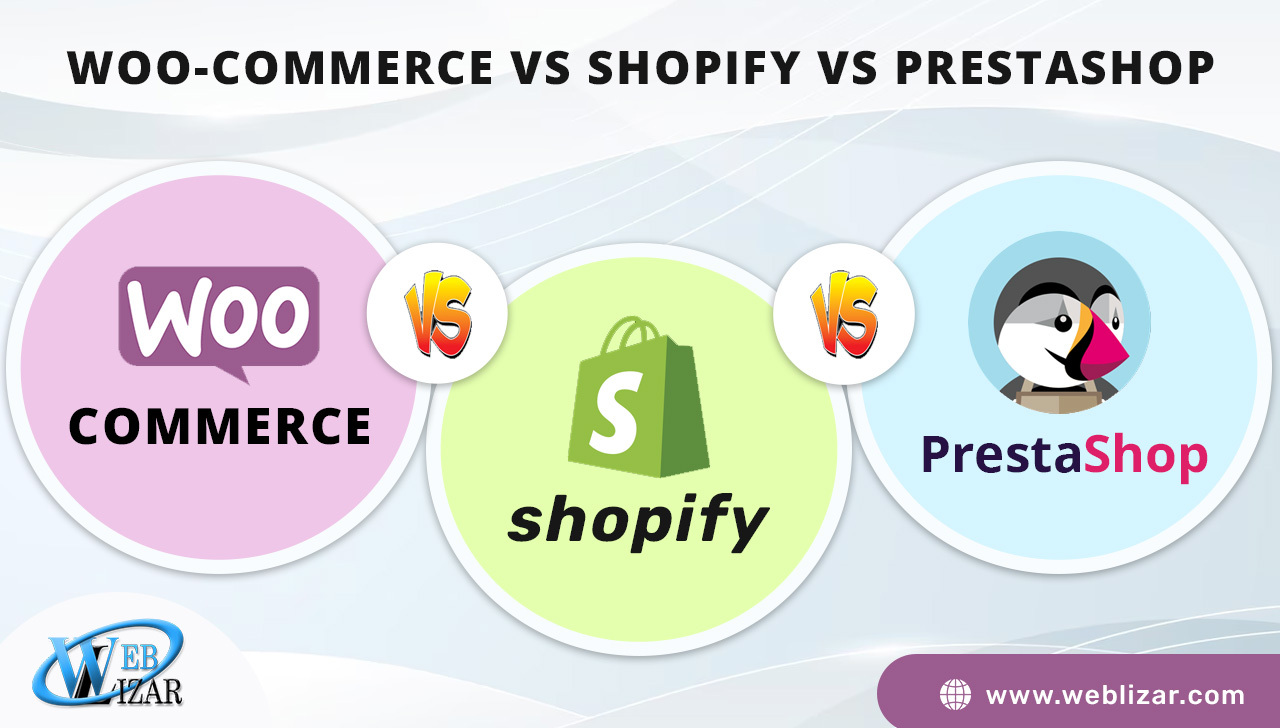Woo-commerce VS Shopify VS Prestashop: Which Is Best In 2024

Woo-commerce VS Shopify VS Prestashop: The internet is not just a great tool to use for doing research. But you can also use it as a platform for your business. In the last few years, eCommerce businesses have been popping out left and right. Because of how convenient it is to do business online.
Now, if you’re planning on going down the same route, then one of the most important things you need to consider would be the eCommerce platform you’re going to use.
This is because you need a website or any other web property to create a digital marketing campaign from which you can start your business.
There are three major choices when it comes to eCommerce platforms for 2019 namely WooCommerce, Shopify, and Prestashop. We’re going to go over the different pros and cons of each one of these choices. So that you can come up with a good decision for your business. Woo-commerce VS Shopify VS Prestashop.
Woo-commerce VS Shopify VS Prestashop 2024
WooCommerce
When it comes to aesthetics, WooCommerce has a lot to offer. If you want your eCommerce website to look great, you just need to put in the hours.
It’s a plugin that was made by the developers at WooThemes. Because of that, it doesn’t carry with it any specific design characteristics. It’s mainly designed to provide you with a way to sell your different products and services online.
If your main concern is design, then you’re in for a treat with WooCoomerce because it’s an open source. That means that there are over a thousand different themes available out there for all the different industries that you can think of. The plugin has been designed to work or cooperate with the majority of the themes available in the market, given that they follow the best practices and standard recommendations.
With that, you can choose any WordPress theme you want without having to worry about it being able to work well with WooCommerce. With that said, it’s safe to conclude that WooCommerce has a huge advantage over Shopify and Prestashop when it comes to designs.
One downside of WooCommerce on the other hand would be its pricing. Unlike Shopify, it doesn’t have a clear and straightforward cost. Even though it’s a free open-source software plugin, you still need to consider the different additional costs that you’re going to deal with when you put up your online store.
If you use WooCommerce, your overall cost can range between $5 and $100 per month and that’s just for the hosting. You need to deal with other costs on top of that such as your SSL certificate.
When it comes to actually selling products, being an open-source software, WooCommerce allows you to easily access different extensions and plugins that serve different purposes such as adding more design; letting you sell on Facebook; and boosting your email marketing campaigns.
When it comes to technical support, since WooCommerce is a free plugin, you’re going to have to dig through different WordPress forums if you’re dealing with a problem on your store. Compare three Woo-commerce VS Shopify VS Prestashop.
People Also Check: How to Use Variation Swatches for WooCommerce
Shopify
The biggest advantage of Shopify over the two other choices would be its cost since you just need to cover $29 for hosting per month and $9 annually for your domain name. When it comes to design, Shopify doesn’t fall too far behind WooCommerce because of the great quality of its themes. Most of the themes available on Shopfy look fantastic right out of the box so you won’t have to do any more major tweaks on them.
There are over 54 different store templates available for you to choose from so finding a look that will easily match your products won’t be an issue. On top of the many options available, the themes on Shopify are also mobile-responsive and offer different coloring options.
Though there are lots of themes available. Some users have complained that the theme that they’ve used has become too common so their store looks similar to a lot of other stores. With that said, you need to do some customization if you want your website to stand out from the rest.
Shopify is very easy to use. Even though you’ll need to install a couple of different apps so that you can make the most out of this platform, they provide you with a ton of free options to begin with such as unlimited file storage; discount codes; credit card payments; daily backups; a Facebook selling module; a fully featured and functional mobile app; and many others.
Another great advantage of using Shopify would be the fact that they handle the payments. And they also offer excellent shipping features such as order tracking and label printing.
If you need any help with your platform. You can easily get access to quality customer care because Shopify offers 24/7 technical support.
Also Checkout: How to Build an eCommerce Website with WordPress? (2024)
Prestashop
Just like WooCommerce, Prestashop is also free. This means that it lets its users handle all of the backend functions of their online stores. With that, you can customize your store’s interface; manage your customers’ orders; keep track of your inventory; and process payments.
One of the biggest advantages of Prestashop is that it’s very easy to install and you can quickly set it up and deploy your store afterwards. Even though it’s a free product, Prestashop offers a lot of great features.
On the other hand, one major downside that users say is that it’s not ideal for people who don’t have advanced knowledge about coding. In addition to that, they said that it’s best suited for people who only need or want a simple online store interface.
Even though it’s free, the add-ons that you may want to get to improve the overall design and functionality of your online store can range anywhere between $50 and $150 per module. These modules include Loyalty Coupons, SEO Expert, Abandoned Cart Reminder, and many others.
Just like WooCommerce, Prestashop also doesn’t have an official support team so you won’t have anyone to help you directly in case you encounter any problems with your store. However, Prestashop has a very active user community with over 700,000 members where you can go to seek help.
Also Check Out: Best eCommerce Platforms for Artists In 2024
Conclusion – Woo-commerce VS Shopify
Woo-commerce VS Shopify VS Prestashop, When it comes to putting up an e-commerce website, there are a ton of things to consider, which means that none of the choices that we’ve discussed has a clear advantage over the others. It all depends on what your budget is and what your needs are. Plus, it’s all going to boil down to how you’re good at maximizing your online platform. So that you can make a lot of sales.
FAQs”
Is PrestaShop better than WooCommerce?
The choice between PrestaShop and WooCommerce depends on specific needs. PrestaShop is a standalone e-commerce platform, while WooCommerce is a WordPress plugin. PrestaShop is more feature-rich out of the box, while WooCommerce offers seamless integration with WordPress and is often preferred for content-heavy sites. Choose based on your website requirements and platform familiarity.
Is it worth moving from WooCommerce to Shopify?
Whether it's worth moving from WooCommerce to Shopify depends on your specific needs. Shopify offers simplicity and ease of use, while WooCommerce provides more customization options on WordPress. Consider factors like scalability, ease of management, and desired features before making a decision.
Is it better to use WooCommerce or Shopify?
The choice between WooCommerce and Shopify depends on preferences and needs. WooCommerce is more customizable, ideal for WordPress users. Shopify is user-friendly and offers a complete package for ease of use.



Leave a Reply